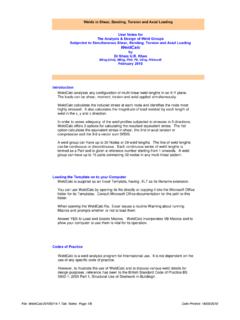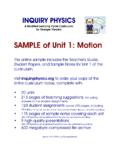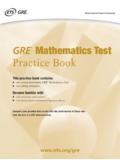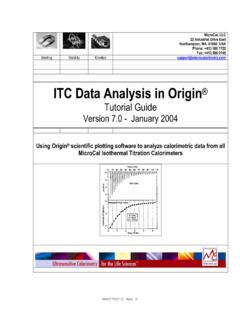Transcription of Horological Wheel Cutting - (Jerry Kieffer’s) …
1 1 Horological Wheel Cutting - ( jerry kieffer s) Modern Means & Methods Authored By: David M. Morrow, CC21 Twenty First Century Certified Clockmaker American Watchmakers-Clockmakers Institute 2 Table of Contents/Index Page(s) Introduction 4 Tooth Forms 5-8 Involute 6 Cycloidal 7-8 Cutters 9-16 Theory 9 Commercial Cutters 10-12 Involute Cutters 10 Cycloidal Cutters 11-12 Custom Single Point Cutter a/k/a Fly Cutters 13-14 More About DP & Module 14-16 Helpful tips for micro milling 17-18 Section 1: Cutting Train Wheel Teeth 19-70 Summary of Major Tasks 19 Task 1: Calculations for Wheel Cutting 20-25 Task 2.
2 Material choices and specifications 26-28 for arbor, tightening washer, backer plate and end mills Task 3: Machine the arbor 29-34 Task 4: Tightening washer: Buy it or machine it 35 Task 5: Machine backer plate 35 Task 6: Machine Wheel blank 36-43 Boring bar tools: Buying, making & using 37-42 Task 7: Machine single point cutter 44-59 Wheel Cutting Worksheet/Calculating Work Point Offsets 44-45 First Cut 50-52 Second Cut 52 Third Cuts 53-55 Fourth Cuts 56-58 Round Bottom Tooth Spaces 59 Task 8: Harden single point cutter 60 Task 9: Sharpen single point cutter 61 Task 10: Milling machine/CNC rotary table setup 61-65 Task 11: Wheel Cutting 66-71 Resizing Wheel Teeth 71 3 Section 2: Cutting Escape Wheels 72-86 Grinding pallet surfaces 84-86 Using a micro mill as a surface grinder 86 Section 3: Cutting Ratchet Wheels 87-101 Section 4: Replacing Teeth on Mainspring Barrels 102-110 Cutting Radial Slots in Train Wheels 111-113 Section 5: Spoking Wheels 114-116 Conclusion 117 Bibliography 118-119 SAFETY NOTE: DURING ALL MACHINING OPERATIONS, PLEASE USE YOUR SAFETY GLASSES.
3 For those of us who wear glasses, an alternative you might try is prescription safety glasses from your nearby eye vision store. Ask for the ANSI approved models. Be warned they won t pass any fashion tests . But, they work really good, particularly when you attach one of Behr s non- distortion single or double eye loupes50. 4 Introduction One of the holy grails in horology is the mastery of Wheel Cutting . As part of studying the many Wheel Cutting means and methods, prescribed by the masters and amateurs alike, I happened upon a means and method taught by jerry kieffer ( jerry , JK). jerry , a self made master micro- machinist who hails from the state of Wisconsin, teaches the method at NAWCC.
4 I took the two day course and afterwards practiced until I was able to obtain repeatable, good outcomes. It is hard for me to believe that now I am able to make custom single point cutters a/k/a fly cutters, grind form tools to cut escape wheels, cut train wheels and even ratchet wheels. I am finally beginning to feel like a real clockmaker. Hucklebee said it it is not until you make a clock or two does one really feel like a clockmaker . These writings originally started out as clockmaker notes and they grew from there. So, I hope you will enjoy my journey as much as I did. First though, I need to point out three important aspects of jerry s means and methods 1) modern machine tools are used, not the traditional clockmaker tools and methods 2) access to a micro mill and lathe such as Sherline s product lines with their precision accuracy is essential and 3) Sherline s CNC rotary table with its programmable controller is used in place of traditional indexing tools.
5 The primary focus of this article is a step by step set of instructions for modern day Wheel Cutting . Included within that are general observations, those nuances and bits of information that make all the difference between success and failure, excerpts from jerry s class, subsequent discussions with jerry and plenty of pictures all overlaid by my observations and lessons learned from mastering the particular technique or concept. As jerry says, he teaches a concept. He expects folks to adapt it to their own preferences and develop their own particular modern means and method . There are several types of clock wheels that need to be cut.
6 Included are train wheels, escape wheels (both recoil and deadbeat), ratchet wheels and mainspring barrels and each of them require a unique form Cutting tool. Discussions on each of these types will be incorporated into this text and pictorial journey via Sections I, II, III & IV respectively. A bit of a discussion is also included on non- Horological gearing. Clockmakers should be able to distinguish the differences between Horological and non- Horological gearing as they will encounter each in readings and in boot sales and the facts and observations provided herein will make for a greater understanding.
7 Lastly, there are some side trip discussions that seemed appropriate to include. All that said, the credit for the content of this article goes to jerry kieffer . It is his concept and his means and methods. While I ve adapted my preferences, and perhaps coined some phrases, it is because of jerry that I am able to present this article. My contribution was simply to have taken the time to attend jerry s class, practice (a lot) and write this text and pictorial journey. Beyond that, the credit and my thanks goes to jerry for his time and ingenuity to develop this modern means and method for Wheel Cutting for today s 21st century clockmakers.
8 5 Tooth Forms Some perspective on tooth forms and gearing principles from another respected gearing Ivan Law:1 There are two geometric curves that can be employed to give us the conditions we require for rolling contact. One curve is based on a shape called the cycloid and the second is based on the involute curve. Gears can be, and are, made to both standards but gears made to one standard must not be meshed with gears based on the other curve. A cycloid is the curve which is described by a point fixed at the circumference of a circle when that circle is rolled in contact with a straight line The involute curve as applied to gear teeth is a geometrical curve traced by a point in a flexible inextendable cord being unwound from a circular disc.
9 Gears based upon the cycloidal curve do maintain constant velocity between their two pitch circle diameters ( ) but this is only true so long as the two s are touching each other. If, for any reason, the gear centers are opened out and their s lose contact then the constant velocity condition will not be met. This means that if the Wheel centers are not accurately set in the first place, or, as is more likely the Wheel bearing wears, allowing the gear centers to spread, the constant velocity will be lost. On the other hand, if the gear teeth are shaped on the involute curve then the constant velocity condition will not be affected by a small amount of spreading of the gear Wheel centers, which means that any normal wear in the gear Wheel bearings will not adversely affect the proper action of the gear teeth.
10 This condition spreading of the gear Wheel centers as described by Ivan Law is most noticeable to us clockmakers in the form of the egg-shaped pivot holes that we encounter in our clock repairs and that require our re-bushing. 6 Involute: In the regular non-horolgical world of gear Cutting is the involute tooth form. The curvature starts from the bottom (root) and continues to the top (addendum) of the tooth and is sized in diametrical pitch or DP . Two involute gears, the left driving the right: Blue arrows show the contact forces between them. The force line (or Line of Action) runs along a tangent common to both base circles.




